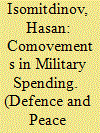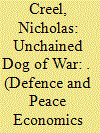|
|
|
Sort Order |
|
|
|
Items / Page
|
|
|
|
|
|
|
| Srl | Item |
| 1 |
ID:
189450


|
|
|
|
|
| Summary/Abstract |
This study examines the trend and comovements of military expenditures across 70 countries from 1967 to 2018. While previous research recognizes the degree of cross-correlations using principal components analysis, we adopt a dynamic factor model with time-varying stochastic volatility to examine the trend and comovements in military spending. Specifically, the dynamic factor model allows us to partition the trend of military spending into global, regional, and country-specific components. We find significant evidence of the global factor that explains a considerable portion of the variation in military spending across countries. Moreover, our findings reveal a significant time variation in the importance of the global factor. We also show the presence of regional and country-specific factors in the military spending of countries, but the importance of the regional factor is less than that of the global and country-specific factors. Additionally, we find that countries under consideration are becoming less exposed to global influences with respect to their decisions in military spending over time.
|
|
|
|
|
|
|
|
|
|
|
|
|
|
|
|
| 2 |
ID:
189452


|
|
|
|
|
| Summary/Abstract |
Veterans exit military service with varying degrees of service-connected disabilities (SCD). The GI Bill provides educational benefits, which increased substantially in 2009 (‘Post-9/11 GI Bill’). Exploiting the exogeneity of SCD and using a difference-in-difference approach, we find that SCD veterans are 16.2 percent more likely to attend college than non-SCD veterans due to the Post-9/11 GI Bill, an effect driven by lower-level SCD veterans attending public colleges. After the benefit increase many lower-level SCD veterans switch from being employed to attending college. We provide insights into the disabled veterans’ college-employment tradeoffs and find that the benefit likely helps disabled veterans improve their labor market outcomes. Future changes in the distribution of SCD levels among veterans will translate into changes in the demand for higher education. Also, the high responsiveness to a more generous financial aid for higher education among disabled veterans may provide useful insights into the effective design of similar subsidies for civilian disabled populations.
|
|
|
|
|
|
|
|
|
|
|
|
|
|
|
|
| 3 |
ID:
189451


|
|
|
|
|
| Summary/Abstract |
Disarmament, Demobilization, and Reintegration (DDR) programs are known to be a necessary component to achieve sustainable peace after an armed conflict. The main goal of this type of program is to help the transition for former soldiers from war to a sustainable legal economic activity. However, due to weak institutions and poor design and implementation, such programs often result in many former soldiers ending up unemployed, in criminal activities, or returning to armed rebel groups. In this paper, I propose an optimal reintegration contract using tools from unemployment insurance literature. In this model, a principal (government) collects taxes from the community to fund a reintegration program that gives incentives to agents (insurgent soldiers) to leave war and search for a job. I describe how information asymmetries and the conditions of labor and crime markets shape the benefits scheme offered by the principal and the selection of insurgents who join the reintegration program.
|
|
|
|
|
|
|
|
|
|
|
|
|
|
|
|
| 4 |
ID:
189454


|
|
|
|
|
| Summary/Abstract |
It is often argued that rebuilding state capacity following intrastate conflict will serve to stabilize the post-conflict environment. Past scholarship has sought to formally model the effect of rising state capacity. Yet, two models of post-conflict environments produce conflicting expectations for the effect of state capacity on the commitment problem and the prospect for peace agreement implementation. This project summarizes the core logic of the two models, compares and contrasts their assumptions, and derives a set of hypotheses about the implementation of peace agreements. These hypotheses are tested using data from the Peace Accords Matrix. The empirical findings indicate that increases in military capacity are associated with lower levels of peace agreement implementation. However, increases in state capacity related to the rule of law are associated with higher levels of implementation. The starting level of coercive and administrative capacity appears to be uncorrelated with the degree to which peace agreements are implemented. This finding points to a possible early warning for peace agreement breakdown. Likewise, it suggests that state building may be less a driver of post-conflict success than it is a manifestation of the preferences of key actors.
|
|
|
|
|
|
|
|
|
|
|
|
|
|
|
|
| 5 |
ID:
189453


|
|
|
|
|
| Summary/Abstract |
This paper studies the determinants of terrorism at the sub-national level in Colombia during 2001–2014. In order to establish robust relationships, a Bayesian model averaging framework has been implemented using departmental data. We find that the violence suffered by this country is linked to economic factors, especially labor market outcomes. The results obtained are not significantly altered by the use of relative measures of terror, the specification of alternative parameters and model priors or the presence of spatial dependence. The main conclusion drawn from our analysis is that an appropriate strategy to fight against terrorism in similar contexts is to increase its opportunity cost. This might be achieved through the promotion of inclusive socioeconomic development, primarily in rural areas.
|
|
|
|
|
|
|
|
|
|
|
|
|
|
|
|
| 6 |
ID:
189449


|
|
|
|
|
| Summary/Abstract |
Research on the constraint President’s face in matters of foreign policy is generally of the view that they are largely free to do as they please. Some research however posits that Congressional constrain on the executive is in fact much larger than it is given credit for. Using their research as a jumping off point, I re-examine this matter by asking when the President will seek ex ante Congressional authorization for the use of force. I estimate this potential effect of Congressional constraint on the President by looking at US initiated militarized interstate disputes with at least one fatality. In so doing, it is demonstrated that no Congressional constrain exists in this regard; the President rarely seeks ex ante authorization for the use of force and is therefore not truly constrained in its use. In fact, evidence is brought to bear that if anything the diversionary theory of war initiation may hold water; inflation is shown herein to be negatively linked to ex ante Congressional authorization for the use of force. It seems as though the President is less likely to ask Congress for permission to conduct deadly military operations when inflation is high.
|
|
|
|
|
|
|
|
|
|
|
|
|
|
|
|
|
|
|
|
|